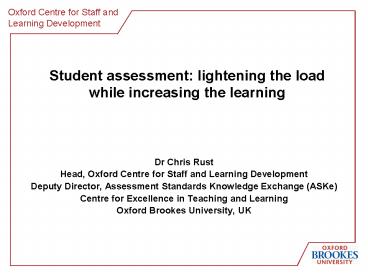Student assessment: lightening the load while increasing the learning - PowerPoint PPT Presentation
1 / 12
Title: Student assessment: lightening the load while increasing the learning
1
Student assessment lightening the load while
increasing the learning
- Dr Chris Rust
- Head, Oxford Centre for Staff and Learning
Development - Deputy Director, Assessment Standards Knowledge
Exchange (ASKe) - Centre for Excellence in Teaching and Learning
- Oxford Brookes University, UK
2
3 possible ways of reducing staff assessment load
- Involve the students
- Mechanise
- Strategic programme decisions
3
Involve the students - 1 self assessment
- Strengths of this piece of work
- Weaknesses in this piece of work
- How this work could be improved
- The grade it deserves is..
- What I would like your comments on
it is the interaction between both believing in
self-responsibility and using assessment
formatively that leads to greater educational
achievements (Brown Hirschfeld, 2008)
4
Marking exercise
- Immediate results participants av. mk non
participants av. mk. - Cohort 1 (99/00) 59.78 54.12
- Cohort 2 (00/01) 59.86 52.86
- Cohort 3 (01/02 55.7 49.7
- Results 1 year later
- Cohort 1 57.91 51.3
- Cohort 2 56.4 51.7
- Rust, C., Price, M ODonovan, B.(2003)
"Improving students learning by - developing their understanding of assessment
criteria and processes - Assessment and Evaluation in Higher Education,
Vol. 28, No. 2
5
Peer marking using model answers (Forbes
Spence, 1991)
- Scenario
- Engineering students had weekly maths problem
sheets marked and problem classes - Increased student numbers meant marking
impossible and problem classes big enough to hide
in - Students stopped doing problems
- Exam marks declined (Average 55gt45)
- Solution
- Course requirement to complete 50 problem sheets
- Peer assessed at six lecture sessions but marks
do not count - Exams and teaching unchanged
- Outcome Exam marks increased (Av. 45gt80)
6
Peer feedback - Geography (Rust, 2001)
- Scenario
- Geography students did two essays but no apparent
improvement from one to the other despite lots of
tutor time writing feedback - Increased student numbers made tutor workload
impossible - Solution
- Only one essay but first draft required part way
through course - Students read and give each other feedback on
their draft essays - Students rewrite the essay in the light of the
feedback - In addition to the final draft, students also
submit a summary of how the 2nd draft has been
altered from the1st in the light of the feedback - Outcome Much better essays
7
Peer feedback - Computing (Zeller, 2000)
- The Praktomat system allows students to read,
review, and assess each others programs in order
to improve quality and style. After a successful
submission, the student can retrieve and review a
program of some fellow student selected by
Praktomat. After the review is complete, the
student may obtain reviews and re-submit improved
versions of his program. The reviewing process is
independent of grading the risk of plagiarism is
narrowed by personalized assignments and
automatic testing of submitted programs. - In a survey, more than two thirds of the
students affirmed that reading each others
programs improved their program quality this is
also confirmed by statistical data. An evaluation
shows that program readability improved
significantly for students that had written or
received reviews. - Available at http//www.infosun.fim.unipa
ssau.de/st/papers/iticse2000/iticse2000.pdf
8
Mechanise assessment
- Statement banks
- Assignment attachment sheets
- Optical mark reader
- Computer aided-assessment
9
Mechanise assessment - 1 Statement Banks
- Write out frequently used feedback comments,
- for example
- I like this sentence/section because it is clear
and concise - I found this paragraph/section/essay well
organised and easy to follow - I am afraid I am lost. This paragraph/section is
unclear and leaves me confused as to what you
mean - I would understand and be more convinced if you
gave an example/quote/statistic to support this - It would really help if you presented this data
in a table - This is an important point and you make it well
- etc.
10
Weekly CAA testing - case study data
(Brown, Rust Gibbs,1994)
11
CAA quizzes (Catley, 2005)
- Scenario
- First term, first year compulsory law module
- A new subject for most (75) students
- High failure rate (25), poor general results
(28 3rd class, 7 Ist) - Solution
- Weekly optional WebCT quizzes (50 take-up)
- Outcome
- Quiz takers 4 fail, 14 3rd class, 24 Ist
- Non-quiz takers same pattern as before
- Overall 14 fail (approx half previous figure)
- 21 3rd class
- 14 1st (double previous figure)
12
Assessing a selection (Rust, 2001)
- Scenario
- Weekly lab reports submitted for marking
- Increased student numbers meant heavy staff
workload and increasingly lengthy gap before
returned so feedback of limited/no use - Solution
- Weekly lab reports still submitted
- Sample number looked at, and generic feedback
e-mailed to all students within 48 hours - At end of semester, only three weeks lab reports
selected for summative marking - Outcome
- Better lab reports and significantly less marking































